Choosing the right sports bra is of utmost importance for women who engage in physical activities. Whether you’re an avid runner, a dedicated yogi, or simply enjoy staying active, a well-fitting sports bra can make a world of difference in your workout experience. It goes beyond just fashion and style; it’s about finding a bra that provides the perfect blend of comfort, support, and functionality.
When it comes to sports bras, one size does not fit all. Every woman’s body is unique, and different activities require different levels of support. A high-impact sport like running necessitates more support to minimize breast movement, while a low-impact activity like yoga may prioritize comfort and flexibility.
Comfort is a key factor in choosing a sports bra. You want to feel at ease during your workouts, without any discomfort or distractions. The fabric should be soft, breathable, and moisture-wicking to keep you cool and dry. Additionally, a sports bra that fits well will offer freedom of movement and prevent chafing.
Support is another crucial aspect to consider. Breasts are made up of fragile ligaments, and inadequate support can lead to discomfort, pain, and potential long-term damage. A sports bra should provide proper support to minimize bounce and movement, reducing the strain on breast tissue.
Functionality is equally important. Sports bras come in various designs, such as racerback, pullover, or hook-and-eye closures, each offering different levels of support and ease of wear. Some sports bras even feature adjustable straps or removable padding for customizable comfort.
By prioritizing comfort, support, and functionality, you can enhance your workout experience, boost your confidence, and protect your breast health. In the following sections, we will delve into the differences between sports bras and gym bras, address common concerns, explore the advantages and disadvantages, and provide detailed product reviews of some of the best sports bras for women. So, let’s find the perfect sports bra that will help you unleash your full potential during your favorite activities!
Difference between Sports Bras and Gym Bras:
While sports bras and gym bras may appear similar at first glance, there are distinct differences in their design and intended purpose. Understanding these differences can help you make an informed decision when choosing the right type of bra for your specific needs.
Sports Bras:
Sports bras are specifically designed to provide optimal support and comfort during physical activities. They are engineered to minimize breast movement, reduce discomfort, and prevent potential damage to delicate breast tissue. Here are some key features that make sports bras suitable for active pursuits:
- Support: Sports bras offer varying levels of support, ranging from low to high impact. High-impact sports bras typically have more structure, encapsulating each breast individually to minimize bounce and provide maximum support. Medium-impact and low-impact sports bras offer varying degrees of compression and support based on the activity level.
- Compression: Many sports bras use compression technology to hold the breasts firmly against the chest wall. This compression minimizes movement in all directions, reducing strain on breast ligaments. It ensures a secure and comfortable fit, allowing you to focus on your workout without distractions.
- Moisture-wicking Fabric: Sports bras are typically made from moisture-wicking materials that draw sweat away from the skin, keeping you dry and comfortable during intense workouts. This feature helps regulate body temperature and prevents chafing or skin irritation.
- Wide Straps and Racerback Designs: Sports bras often feature wider straps or a racerback design. The wide straps distribute weight evenly across the shoulders, reducing pressure points. Racerback styles enhance shoulder mobility and prevent straps from slipping during vigorous movements.
- Breathability: Good sports bras are made from breathable fabrics that promote air circulation, allowing heat to escape and keeping you cool. Mesh panels or perforated details are often incorporated into the design to enhance ventilation.
Gym Bras:
Gym bras, on the other hand, are generally more versatile and suitable for low-impact activities or casual workouts. They offer light support and are often designed with a focus on style and comfort rather than intense physical activity. Here are a few distinguishing characteristics of gym bras:
- Light Support: Gym bras provide minimal support, making them ideal for activities that involve less movement, such as weightlifting, stretching, or light cardio exercises. They typically lack the structure and compression found in sports bras.
- Comfortable Materials: Gym bras prioritize comfort and are often made from soft, stretchy fabrics that allow for unrestricted movement. They may feature thinner straps or a simpler design, focusing on ease of wear rather than targeted support.
- Style and Versatility: Gym bras come in a wide range of designs, colors, and patterns, catering to personal style preferences. They can be worn not only for workouts but also as a casual everyday bra under casual attire.
It’s important to note that the level of support needed varies depending on the activity and individual preferences. For high-impact activities like running or intense cardio workouts, a sports bra with superior support and stability is recommended. For lighter activities or a more relaxed workout routine, a gym bra may suffice.
By understanding the differences between sports bras and gym bras, you can make an informed choice that aligns with your activity level, support requirements, and personal preferences.
Top 7 Sports Bra for women’s
1. Cabales Women’s Pull On Style Seamless Comfortable Wire-Free Yoga Bra with Removable Pads
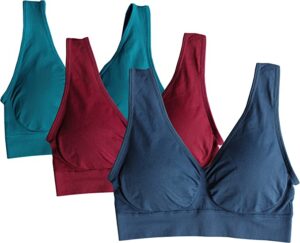
The Cabales Women’s Yoga Bra features a pull-on style with no hooks or wires, providing a seamless and comfortable fit. The bra is constructed with a blend of nylon and spandex, offering excellent stretch and flexibility. The removable pads allow for customization and shaping, while the wide shoulder straps enhance support and reduce pressure on the shoulders.
Pros:
- Seamless and wire-free design for maximum comfort.
- Soft and stretchy fabric provides a snug and supportive fit.
- Removable pads offer versatility and shaping options.
- Wide shoulder straps distribute weight evenly and reduce discomfort.
Cons:
- Some users found the sizing to be inconsistent.
- The band may stretch out over time, requiring frequent adjustments.
- Limited color options available.
2. Vermilion Bird Women’s 3 Pack Seamless Comfortable Sports Bra with Removable Pads:
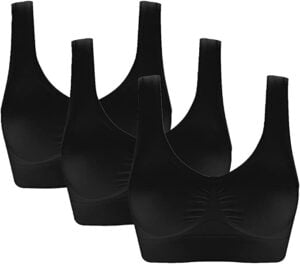
The Vermilion Bird Women’s Sports Bra offers a seamless design and comes in a convenient pack of three. The bras are made of a comfortable and stretchy fabric that provides a soft and smooth feel against the skin. The removable pads offer additional shape and coverage. The sports bras provide medium support, making them suitable for activities like yoga, Pilates, or light cardio workouts.
Pros:
- Seamless design reduces friction and irritation.
- Stretchy fabric offers a comfortable and flexible fit.
- Removable pads allow for customization and added shape.
- Affordable three-pack option for convenience and value.
Cons:
- Some users reported limited support for high-impact activities.
- Sizing may run small, so it’s recommended to check the size chart before purchasing.
3. Evercute Cross Back Sport Bras Padded Strappy Criss Cross Cropped Bras for Yoga Workout Fitness Low Impact:
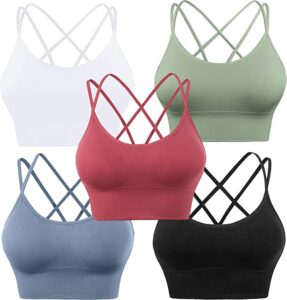
The Evercute Cross Back Sport Bra features a stylish crisscross design at the back, adding a unique and fashionable touch. The bra offers low-impact support and is ideal for activities like yoga, weightlifting, or light cardio. The padded cups provide additional shape and coverage, while the wide underbust band offers comfortable support and stability.
Pros:
- Fashionable crisscross design adds a trendy look to your workout attire.
- Padded cups enhance shape and coverage.
- Wide underbust band provides a secure and supportive fit.
- Soft and stretchy fabric ensures comfort during workouts.
Cons:
- Limited support for high-impact activities.
- Some users found the sizing to be smaller than expected.
- The straps may slip or dig into the shoulders during intense movements.
4. Sports Crop Tank Tops for Women Cropped Workout Tops Racerback Running Yoga Tanks Cotton Sleeveless Gym Shirts 3 Pack:
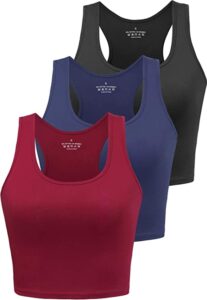
The Sports Crop Tank Tops for Women provide a versatile and comfortable option for workouts or casual wear. These cropped tank tops feature a racerback design for ease of movement and are made from breathable cotton fabric. The pack includes three tanks in different colors, offering variety and style.
Features:
- Racerback design allows for freedom of movement.
- Made from breathable cotton fabric.
- Cropped length for a trendy look.
- Suitable for a range of activities.
- Comes in a convenient 3-pack.
Pros:
- Soft and breathable cotton fabric.
- Racerback design enhances mobility.
- Versatile for both workouts and casual wear.
- Offers a variety of colors in one pack.
Cons:
- May not provide sufficient support for high-impact activities.
- Some users find the tanks to be shorter in length.
5. ODODOS Women’s Crop 3-Pack Washed Seamless Rib-Knit Camisole Crop Tank Tops:
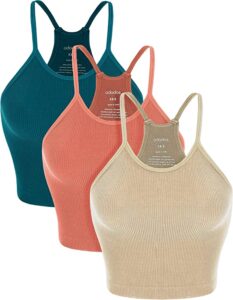
The ODODOS Women’s Crop 3-Pack Washed Seamless Rib-Knit Camisole Crop Tank Tops offer a comfortable and stylish option for workouts or everyday wear. These crop tank tops feature a rib-knit design and are made from a seamless fabric blend. The pack includes three tanks in different colors for added variety.
Features:
- Rib-knit design adds texture and style.
- Seamless construction for a smooth and comfortable fit.
- Cropped length for a trendy look.
- Versatile for workouts or casual wear.
- Available in a convenient 3-pack.
Pros:
- Comfortable and stretchy fabric.
- Trendy rib-knit design adds texture.
- Versatile for various activities and outfits.
- Offers a variety of colors in one pack.
Cons:
- Some users find the sizing to be smaller than expected.
- May not provide sufficient support for high-impact activities.
It’s important to note that individual experiences may vary, and it’s recommended to read customer reviews and consider your personal preferences when choosing a sports bra.
6. OQQ Women’s 3 Piece Medium Support Crop Top Seamless Ribbed Removable Cups Workout Yoga Sport Bra:
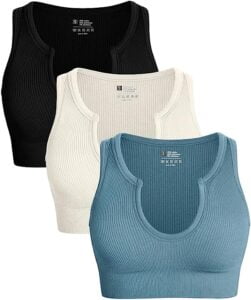
The OQQ Women’s 3 Piece Medium Support Crop Top Seamless Ribbed Sports Bra offers a stylish and functional option for women seeking medium support during their workouts. The ribbed design adds a trendy touch while the removable cups provide shape and support. The sports bras are made from a seamless, moisture-wicking fabric for ultimate comfort.
Features:
- Ribbed design adds a fashionable element.
- Medium support for a range of activities.
- Seamless construction minimizes chafing and discomfort.
- Moisture-wicking fabric keeps you cool and dry.
- Removable cups for customizable support and shape.
Pros:
- Stylish design with a ribbed texture.
- Comfortable and breathable fabric.
- Removable cups allow for personalized support.
- Provides medium support for various activities.
Cons:
- Sizing may run small, so consider sizing up.
- Some users find the straps to be slightly narrow.
Why Do Breasts Hurt After Wearing a Sports Bra?
It can be frustrating and uncomfortable to experience breast pain or discomfort after wearing a sports bra, especially when it’s supposed to provide support and enhance your workout experience. Several factors can contribute to this issue, including:
- Improper Fit: One of the most common reasons for breast pain after wearing a sports bra is an improper fit. If your sports bra is too tight or too loose, it can lead to discomfort. A too-tight bra may compress the breasts excessively, causing restricted blood flow and pressure on the breast tissue. On the other hand, a too-loose bra may fail to provide adequate support, allowing excessive movement that can strain the ligaments and cause discomfort.
- Lack of Support: Sports bras are designed to minimize breast movement during physical activities. If your sports bra lacks sufficient support for your breast size or the impact level of your workout, it can result in breast pain. Insufficient support allows excessive bouncing, which can strain the breast tissue and cause discomfort. It’s essential to choose a sports bra that offers the appropriate level of support based on your activity level and breast size.
- Inadequate Fabric: The fabric of your sports bra plays a crucial role in providing comfort and preventing breast pain. If the fabric is rough, abrasive, or lacks moisture-wicking properties, it can lead to irritation, chafing, and discomfort. Additionally, some individuals may be sensitive or allergic to certain fabrics, causing breast discomfort or skin irritation. Opting for sports bras made from soft, breathable, and moisture-wicking materials can help alleviate this issue.
- Strap or Band Pressure: The straps and band of a sports bra should provide support without causing undue pressure on the breasts. If the straps dig into your shoulders or the band feels too tight, it can lead to breast pain. Properly adjusted and cushioned straps, along with a well-fitting band, distribute the weight of the breasts evenly, reducing pressure points and discomfort.
- Worn-out or Non-Supportive Bra: Over time, sports bras can lose their elasticity and supportive properties, especially with frequent use and washing. If your sports bra has become worn out or no longer provides the necessary support, it can contribute to breast discomfort. It’s important to replace your sports bras regularly, especially if you notice a loss of support or increased discomfort during your workouts.
To alleviate breast pain after wearing a sports bra, consider the following steps:
- Ensure proper fit: Take accurate measurements and choose a sports bra that offers the right level of support for your breast size and activity level. Try on different styles and brands to find the one that fits you best.
- Opt for supportive fabrics: Look for sports bras made from soft, moisture-wicking fabrics that provide breathability and comfort during physical activities.
- Adjust straps and band: Ensure that the straps and band of your sports bra are properly adjusted to avoid excessive pressure on the breasts. Straps should be snug but not digging into your shoulders, while the band should provide a secure yet comfortable fit.
- Replace worn-out bras: If your sports bra has lost its elasticity or no longer provides adequate support, it’s time to replace it with a new one. Regularly check your sports bras for signs of wear and tear and replace them as needed.
By addressing these factors and selecting a well-fitting, supportive sports bra made from comfortable materials, you can reduce the likelihood of breast pain and discomfort during and after your workouts. Remember, your sports bra should enhance your exercise experience, not hinder it.
Why Do Breasts Hurt After Wearing a Sports Bra?
Breast discomfort after wearing a sports bra is a common issue experienced by many women. It can be frustrating and detract from the overall workout experience. Several factors can contribute to this discomfort, including improper fit, lack of support, and inadequate fabric. Understanding these reasons can help you address the issue and find a sports bra that offers both comfort and support.
- Improper Fit: One of the primary reasons for breast discomfort is an ill-fitting sports bra. If the bra is too tight, it can compress the breasts excessively, leading to discomfort, restricted blood flow, and even pain. Conversely, a bra that is too loose may fail to provide the necessary support, allowing excessive breast movement that can strain the breast tissue and ligaments. It is crucial to choose a sports bra with the correct band and cup size to ensure a proper fit and optimal support.
- Lack of Support: Insufficient support is another factor that can cause breast pain when wearing a sports bra. Sports bras are designed to minimize breast movement during physical activities, especially those with high impact. If your sports bra does not provide adequate support for your breast size or the intensity of your workout, the breasts can experience excessive bouncing and movement. This can lead to discomfort, strain on the breast tissue, and potential long-term damage. Opting for a sports bra with appropriate support levels based on your activity level and breast size is crucial for minimizing breast discomfort.
- Inadequate Fabric: The fabric used in sports bras can also contribute to breast discomfort. Rough or abrasive fabrics can irritate the sensitive skin around the breasts, causing chafing, redness, and discomfort. Additionally, fabrics that do not have moisture-wicking properties can trap sweat and moisture, leading to discomfort and potential skin irritation. Choosing sports bras made from soft, breathable, and moisture-wicking materials can help prevent these issues and keep you comfortable during workouts.
- Strap or Band Pressure: The straps and band of a sports bra play a vital role in providing support and distributing the weight of the breasts. If the straps dig into your shoulders or the band feels too tight, it can cause discomfort and pain. Well-designed sports bras incorporate features like padded straps and adjustable bands to ensure proper weight distribution and minimize pressure points. Adjusting the straps and band to the right tension can help alleviate breast discomfort.
By addressing these factors and selecting a sports bra with a proper fit, adequate support, and comfortable fabric, you can reduce breast discomfort during and after workouts. It is important to remember that every woman’s body is unique, and finding the right sports bra may require some trial and error. Don’t hesitate to try different styles, brands, and sizes until you find the one that provides the best comfort and support for your specific needs. Your breasts deserve the right care and support during physical activities to ensure a comfortable and enjoyable workout experience.
Disadvantages of Sports Bras
While sports bras offer numerous benefits for women during physical activities, it’s important to acknowledge that they may come with some potential drawbacks. These disadvantages can vary depending on individual preferences, body types, and activity levels. Here are a few factors that some women may experience as disadvantages when it comes to sports bras:
- Difficulty in Finding the Right Fit: Finding the perfect sports bra that fits well can be a challenge. Women come in a wide range of sizes and shapes, and not all sports bras cater to every body type. Some women may struggle to find a sports bra that provides the right combination of comfort, support, and fit. It may take trial and error, trying different brands, styles, and sizes, to find the ideal sports bra that suits their individual needs.
- Limited Style Options: Compared to traditional bras, sports bras often have a more utilitarian design and prioritize functionality over style. While this is essential for providing the necessary support and minimizing breast movement, it can result in a limited range of style options. Some women who prefer more fashionable or trendy undergarments may feel that sports bras lack the aesthetic appeal they desire. However, the industry is evolving, and there are now sports bras available in a wider variety of designs and colors, catering to different style preferences.
- Potential Discomfort: While sports bras are designed to provide support and minimize breast movement, discomfort can still arise for some women. This can be due to factors such as improper fit, inadequate support, or irritation caused by the fabric or seams. It’s important to choose a sports bra that suits your body type, activity level, and personal comfort preferences. Features like adjustable straps, cushioned bands, and moisture-wicking fabrics can contribute to a more comfortable wearing experience.
- Compression Sensation: Sports bras often use compression technology to hold the breasts firmly against the chest wall, minimizing movement. However, for some women, the sensation of compression can feel constricting or uncomfortable. It’s important to find a balance between compression and comfort when selecting a sports bra. Trying different levels of compression and styles can help determine what works best for your body and preferences.
- Limited Size Range: Although the size range for sports bras has improved over the years, some women with larger bust sizes may still find it challenging to find sports bras that provide adequate support. This can lead to discomfort, limited options, or the need to compromise on fit. However, many brands now offer extended size ranges and specifically cater to larger bust sizes, ensuring that women of all sizes can find suitable sports bras.
It’s important to note that while these disadvantages exist, they can be overcome with careful consideration and exploration of different brands, styles, and sizes. Each woman’s experience with sports bras will be unique, and what may be a disadvantage for one person might not be an issue for another. Ultimately, finding the right sports bra that offers the necessary support, comfort, and style can enhance the overall exercise experience and promote breast health.
Are Sports Bras Supposed to Be Tight?
There is a common misconception that sports bras are meant to be extremely tight or constrictive in order to provide adequate support. However, it’s important to clarify that while sports bras do need to offer support, they should not be overly tight or uncomfortable. Finding the right balance between support and comfort is key when it comes to sports bras.
Sports bras are designed to minimize breast movement during physical activities, particularly high-impact exercises. They are constructed with specialized features such as compression, encapsulation, or a combination of both to provide support and reduce bounce. These features help to protect the delicate breast tissue, prevent discomfort, and minimize the risk of long-term damage.
While it’s true that sports bras should offer a snug fit, this doesn’t mean they should be excessively tight. A well-fitting sports bra should provide a secure, supportive feel without causing discomfort, restriction of movement, or breathing difficulties. It should hold the breasts in place, minimizing vertical and horizontal movement, while allowing for natural range of motion and comfort.
Wearing a sports bra that is too tight can lead to various issues, including:
- Restricted Blood Flow: Excessive compression or tightness can restrict blood flow to the breast tissue, potentially causing discomfort, numbness, or even tissue damage. It’s important to ensure that the sports bra you choose doesn’t impede proper circulation.
- Breathing Difficulties: If a sports bra is overly tight, it can restrict chest expansion, making it difficult to breathe deeply during physical activities. This can impede performance and lead to discomfort or feelings of breathlessness.
- Skin Irritation: Excessive tightness can cause friction and rubbing against the skin, leading to irritation, chafing, or even skin abrasions. A well-fitting sports bra should provide support without causing excessive friction or discomfort.
To find the right fit, it’s crucial to consider both the band and cup size of the sports bra. The band should sit firmly and snugly around the ribcage, providing support and anchoring the bra in place. However, it shouldn’t dig into the skin or leave marks. The cups should encapsulate each breast fully, without causing spillage or compression.
It’s recommended to get professionally fitted or measure yourself accurately to determine your correct sports bra size. Keep in mind that different brands and styles may fit differently, so it’s always beneficial to try on various options to find the most comfortable and supportive fit for your unique body shape.
Remember, the goal of a sports bra is to provide the necessary support and minimize breast movement during physical activities while ensuring comfort and maintaining proper blood flow. Finding the right balance between support and comfort will enhance your workout experience and contribute to overall breast health.
Who Should Wear a Sports Bra?
Wearing a sports bra during physical activities is important for women of all sizes and breast shapes. Whether you’re engaging in high-impact exercises or low-impact activities, a sports bra provides crucial support and offers several benefits that contribute to both comfort and breast health.
Here are some reasons why women should wear sports bras during physical activities:
- Minimizing Breast Movement: The primary purpose of a sports bra is to minimize breast movement during exercise. The breasts are made up of delicate ligaments called Cooper’s ligaments, which, without proper support, can stretch and cause sagging over time. Sports bras, particularly those designed for high-impact activities, help reduce breast movement in all directions, preventing strain on the ligaments and minimizing the risk of long-term damage.
- Enhanced Comfort: Sports bras are designed to provide a snug and supportive fit, which translates to enhanced comfort during workouts. They are typically made from moisture-wicking fabrics that help keep you cool and dry by wicking away sweat from the skin. The absence of underwires or other rigid components found in traditional bras adds to the overall comfort, allowing for greater freedom of movement.
- Improved Performance: By minimizing breast movement and discomfort, sports bras can contribute to improved performance during physical activities. When your breasts are properly supported, you can focus on your workout without distractions or discomfort, allowing you to push yourself further and achieve your fitness goals.
- Protection and Injury Prevention: Sports bras offer protection and help prevent injuries. During physical activities, especially high-impact exercises like running or jumping, the breasts can move significantly. Without adequate support, this movement can lead to discomfort, pain, and potential tissue damage. A sports bra acts as a protective barrier, reducing the risk of breast soreness, discomfort, and injury.
- Suitable for All Breast Sizes: Sports bras are not limited to women with larger breasts. Women of all sizes can benefit from wearing a sports bra during physical activities. Even women with smaller breasts can experience discomfort and movement during workouts, which can be addressed by wearing a sports bra designed for low-impact activities. Sports bras come in various sizes and support levels, ensuring that every woman can find one that fits her body and activity level.
For women with larger breasts, the importance of wearing a sports bra is particularly significant. The added weight of larger breasts can increase the risk of discomfort, pain, and breast tissue damage during exercise. Sports bras specifically designed for larger cup sizes offer additional support, wider straps, and reinforced construction to provide optimal comfort and minimize breast movement.
In summary, wearing a sports bra is essential for women of all sizes during physical activities. The benefits of a sports bra, such as minimizing breast movement, enhancing comfort, improving performance, and protecting breast tissue, make it a crucial piece of athletic wear. Regardless of your breast size, investing in a well-fitting sports bra will contribute to a more comfortable, enjoyable, and supportive exercise experience
Who Uses Sports Bras?
Sports bras have become an essential garment for a wide range of women, offering benefits beyond just athletes and fitness enthusiasts. Today, women from various walks of life and with different needs rely on sports bras for both physical activities and everyday comfort. Here are some groups of women who benefit from using sports bras:
- Athletes and Fitness Enthusiasts: Athletes, whether professional or amateur, understand the importance of proper support during physical activities. Sports bras provide the necessary support and minimize breast movement, allowing athletes to focus on their performance without distractions. From runners and dancers to gym-goers and yogis, sports bras are a staple for women engaged in high-impact and low-impact exercises alike.
- Women Participating in Sports: Women participating in organized sports, such as soccer, basketball, tennis, or volleyball, greatly benefit from sports bras. These bras provide the support needed to minimize breast movement, reducing the risk of discomfort, pain, and potential tissue damage during intense movements. They enable female athletes to move freely, enhance performance, and feel confident on the field or court.
- Women Seeking Everyday Comfort: Sports bras offer comfort beyond physical activities. Many women choose to wear sports bras in their daily lives for their comfortable fit and support. They provide a feeling of security and minimize breast movement during daily activities, whether it’s running errands, working from home, or engaging in light exercises. Sports bras are designed to be breathable, lightweight, and flexible, making them suitable for all-day wear.
- Women with Active Lifestyles: Women leading active lifestyles, even outside of structured exercise routines, find sports bras to be a valuable wardrobe staple. Whether hiking, cycling, or engaging in outdoor activities, a sports bra provides the necessary support and comfort for these pursuits. The versatility of sports bras allows women to seamlessly transition from one activity to another without compromising on support or style.
- Women during Pregnancy and Nursing: Sports bras can be particularly beneficial for pregnant and nursing women. As the breasts undergo changes in size and sensitivity during pregnancy, a well-fitting sports bra provides gentle support and alleviates discomfort. Additionally, some sports bras offer features like adjustable straps or front-closure designs that make breastfeeding easier and more convenient.
- Women Seeking Post-Surgery Support: After undergoing breast surgery, such as augmentation, reduction, or reconstruction, women often require additional support and protection during the healing process. Sports bras designed for post-surgical use provide gentle compression, support, and coverage, promoting proper recovery and comfort.
- Women with Larger Bust Sizes: Women with larger breasts benefit immensely from sports bras that offer superior support and minimize breast movement. These bras are designed with features like wider straps, reinforced construction, and fuller cup coverage to cater to larger bust sizes. By wearing a well-fitted sports bra, women with larger breasts can engage in physical activities comfortably and with confidence.
In summary, sports bras cater to a diverse range of women with different needs. Athletes, fitness enthusiasts, women participating in sports, those seeking everyday comfort, pregnant and nursing women, individuals post-surgery, and women with larger bust sizes all benefit from the support, comfort, and functionality provided by sports bras. Regardless of your lifestyle, activity level, or body shape, there is a sports bra designed to meet your specific requirements and enhance your overall well-being.
How to Determine Your Sports Bra Size
Finding the right sports bra size is crucial to ensure optimal comfort, support, and performance during physical activities. Here are some practical tips to help you measure and determine your correct sports bra size:
- Measure Your Band Size: Start by measuring your underbust, just below your breasts, using a soft measuring tape. Make sure the tape is parallel to the ground and snug but not too tight. Round the measurement to the nearest whole number. This measurement will give you your band size. If the measurement is an even number, add 4 inches (or 10 centimeters) to determine your band size. If the measurement is an odd number, add 5 inches (or 12.5 centimeters) instead.
- Measure Your Bust Size: To determine your cup size, measure the fullest part of your bust while wearing a non-padded bra. Again, ensure the measuring tape is parallel to the ground and not too tight. Subtract your band size measurement from your bust measurement. The difference between the two measurements will help you determine your cup size. Use the following guide to match the difference with the corresponding cup size:
- Difference of 1 inch (or 2.5 centimeters): A cup
- Difference of 2 inches (or 5 centimeters): B cup
- Difference of 3 inches (or 7.5 centimeters): C cup
- Difference of 4 inches (or 10 centimeters): D cup
- Difference of 5 inches (or 12.5 centimeters): DD (or E) cup
- Difference of 6 inches (or 15 centimeters): DDD (or F) cup
- Difference of 7 inches (or 17.5 centimeters): G cup
- Consider Trying Different Styles and Brands: It’s important to remember that not all sports bras are created equal. Different brands and styles may have variations in their sizing and fit. Once you have determined your band and cup size, it’s advisable to try on different sports bras to find the most comfortable and supportive fit for your body shape. Pay attention to features like adjustable straps, hook-and-eye closures, and different levels of support offered by different styles.
- Check for Proper Fit: When trying on a sports bra, make sure the band sits firmly and horizontally around your ribcage, providing support without digging into your skin or riding up. The cups should encapsulate each breast fully, without causing any spillage or compression. The straps should be adjustable and provide a comfortable fit without digging into your shoulders. Ensure that the sports bra feels snug and supportive but not overly tight or constricting.
- Consider Your Activity Level: The level of support required may vary depending on your activity level. High-impact activities like running or aerobics call for sports bras with more support, while low-impact activities like yoga or Pilates may require less support. Consider the intended activity and choose a sports bra that offers the appropriate level of support and comfort for that particular activity.
Remember, finding the right sports bra size may involve some trial and error. Don’t hesitate to experiment with different sizes and styles until you find the perfect fit for your unique body shape and activity needs. Investing the time and effort into determining your correct sports bra size will greatly enhance your comfort, support, and overall enjoyment of physical activities.
